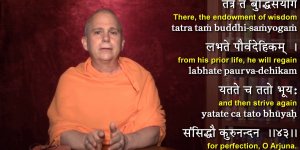| TV Channels / Documentaries |
The Inner Journey: A Course in Meditation
Part 3: Foundations of Practice
A video presentation by Swami Tadatmananda Saraswati, Arsha Bodha Center, United States
(Tapescript)
It's really important to understand that meditation is a learned skill. No one is born with a natural aptitude for meditation.
It's learned the same way you learn any other skill, whether it's driving a car, speaking a foreign language, or playing a musical instrument. To learn a new skill, two things are necessary - proper instruction and a sufficient amount of practice. With the right training and enough practice, you could probably learn to fly an airplane or converse in Chinese.
Fortunately, most meditation techniques are much more simple than flying or Chinese language.
To acquire any new skill, you have to learn the basics first. And that's certainly true of meditation. Learning the fundamentals and practicing simple techniques are prerequisites for the advanced techniques taught later in this course.
A beautiful metaphor compares your initial practice of meditation to a young sapling planted in the soil. A tree can grow tall only when its roots extend deep into the ground. If its roots remain shallow for any reason, its growth will be stunted. Shallow roots also make trees vulnerable to being blown down by storms.
In a similar way, if you fail to learn and practice the basics of meditation properly, the shallow depth of your skills will stunt your progress. And if your practice remains weak, you might abandon it altogether when the storms of life drag your attention away. On the other hand, the deeper a tree's roots have spread into the ground, the taller it can grow and the better it can resist violent winds. Likewise, the stronger your basic practice has grown, the further you can progress with advanced techniques and the better you can maintain your practice while facing the challenges of life.
For building your practice of meditation, you can find an ideal theoretical foundation in the Yoga Sutras of Patanjali. The word yoga comes from the Sanskrit verbal root, yuj, to which the English word yoke is also related. Based on this root, the word yoga has two primary meanings - to unite and to control. Modern teachers of yoga often emphasize only the first of these meanings, to unite, to become united or merged with God or with your higher Self.
But traditional Sanskrit commentaries on the Yoga Sutras mostly emphasize the second meaning, to control. You'll see why as we continue. A yoke is used to harness an animal for pulling a plow or cart. The yoke serves two purposes; first, to join or unite the animal to the plow or cart, and second, to control the animal's movement. In meditation, both of these functions, uniting and controlling, are crucial. Let me explain.
Patanjali prescribes certain practices to control your mind, to rein it in, so to speak.
And these practices eventually lead your mind to a state of union, in which it merges with the object of meditation. In his sutras, Patanjali provides a systematic method for accomplishing this.
His method consists of a series of eight steps, steps that he calls angas or limbs. These eight limbs are like those on a tree. You climb a tree from its lower limbs to the higher ones, and in the same way, you progress from introductory practices to more advanced ones by means of Patanjali's eight angas.
Patanjali defines the eight as yama, rules that restrain you from committing harmful or immoral actions, niyama, rules that oblige you to live a spiritual lifestyle, asana, posture, sitting properly for meditation, pranayama, control of your breath, breathing exercises, pratyahara, sense withdrawal, turning your attention away from the world, dharana, concentration, narrowly focusing your attention on an object of meditation, dhyana, meditation, the uninterrupted flow of your attention towards that object, and samadhi, complete absorption in the object of meditation.
The full significance of this sequence will become more clear as we continue. But in general, the first seven steps specify different kinds of control, control of your activities, your body, your breath, your senses, and your mind. These seven kinds of control culminate in the eighth step, samadhi, a state of divine union. Based on this, you can see why traditional teachers explain the word yoga by emphasizing the meaning, "to control," more than the meaning, "to unite."
Now that we've gotten an overview of yoga's eight angas, we'll examine each of them in detail.
In this lesson, we'll discuss the first two, yama and niyama. The others will be discussed in future lessons.
We'll take yama and niyama together since they're closely related.
As we saw, yama means restraint. This anga prohibits actions that violate the rules of dharma, righteousness, actions like causing harm to others, lying or stealing.
Niyama means observance. This anga requires the performance of certain spiritual disciplines like cleanliness, chastity, prayer, and scriptural study.
Now, you might wonder why Patanjali's system of meditation begins with moral and ethical rules, rules that sound a bit like Biblical commandments. What do these yamas and niyamas have to do with meditation?
Well, suppose a professional tennis player got into a huge argument with her manager, just moments before her final match in a tournament played in front of thousands of spectators. As you know, playing tennis at this professional level requires tremendous concentration. The lingering effects of her earlier argument could quite possibly distract her enough to make her lose the match.
Now, imagine sitting down to meditate just after having an argument with someone. How would that affect you? Your thoughts would probably get drawn back to the argument again and again.
You can't meditate when your mind is preoccupied or distracted.
But such distractions are inevitable whenever you're involved in some kind of strife or conflict. And, if you behave in ways that violate the rules of dharma, strife and conflict will certainly come up in your life. For example, if you hurt someone, they're likely to retaliate in one way or another. What goes around, comes around, as they say.
My guru was fond of saying that to oppose or "rub up" against the rules of dharma is like rubbing your bare arm against the rough bark of a tree. Who rubs whom? he asks.
The tree doesn't get affected at all, but your arm ends up scratched and bleeding.
His metaphor shows how those who rub up against or transgress the rules of dharma usually end up getting entangled in quarrels and disputes with others.
And this results in lots of mental agitation, inner turmoil that's huge obstacle for meditation.
On the other hand, by consistently following the rules of dharma, you can avoid most of those quarrels and disputes, leaving your mind undistracted and fully available for meditation.
So, yama and niyama, restraints and observances, are the very first angas of Patanjali's system of meditation because they help you establish a dharmic lifestyle, a life free from conflict and discord, a life that's well-suited for meditation.
In the next lesson, we'll discuss several specific steps of preparation that are needed for meditation, including asana, posture, the third of Patanjali's angas. Then we'll perform the first guided meditation of this course.

Subscribe now to get unrestricted access to all resources, in all languages, throughout this web site!
Subscription Form
YOU MAY ALSO LIKE




Subscribe now to get unrestricted access to all resources, in all languages, throughout this web site!
Subscription Form

